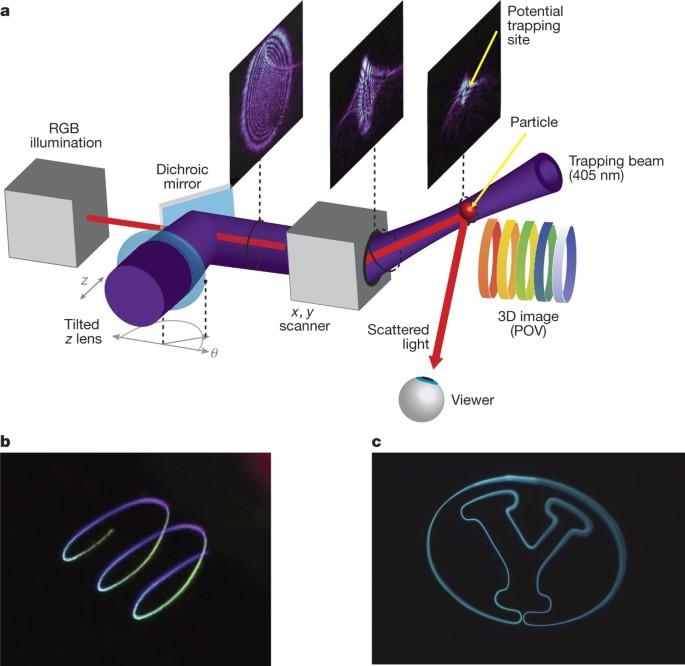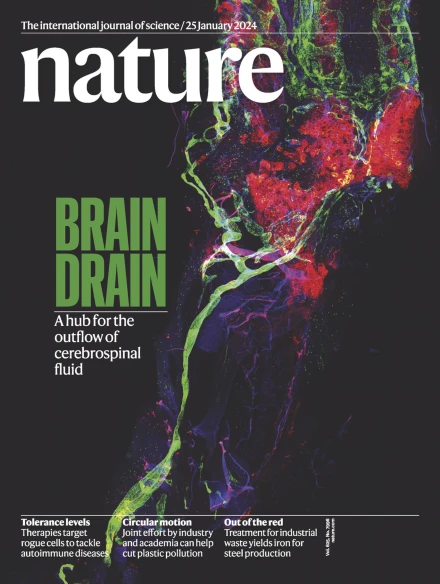A photophoretic-trap volumetric display
IF 50.5
1区 综合性期刊
Q1 MULTIDISCIPLINARY SCIENCES
引用次数: 183
Abstract
Photophoretic optical trapping of cellulose particles and persistence of vision are used to produce real-space volumetric images that can be viewed from all angles, in geometries unachievable by holograms and light-field technologies. Three-dimensional moving images have long been the stuff of science fiction. In reality, the appearance of three dimensions is usually approximated by manipulating light, but such approaches have limitations such as narrow viewing angles and the need for special viewing headwear. Daniel Smalley and colleagues offer a solution in which a three-dimensional object can be represented in real space, viewed from any angle, and even coexist with—and wrap around—solid objects that occupy the same physical volume. A near-invisible light field traps and moves a small particle through a volume of space. As the particle moves, it is illuminated using red, green and blue laser light, producing an arbitrarily coloured point-source that maps out the surface of the object to be imaged. If the particle scanning is fast enough, persistence of vision, which results from the slower ''refresh rate'' of the human eye, gives the appearance of a solid three-dimensional surface. At even faster scanning rates, the imaged object can appear to move. Free-space volumetric displays, or displays that create luminous image points in space, are the technology that most closely resembles the three-dimensional displays of popular fiction1. Such displays are capable of producing images in ‘thin air’ that are visible from almost any direction and are not subject to clipping. Clipping restricts the utility of all three-dimensional displays that modulate light at a two-dimensional surface with an edge boundary; these include holographic displays, nanophotonic arrays, plasmonic displays, lenticular or lenslet displays and all technologies in which the light scattering surface and the image point are physically separate. Here we present a free-space volumetric display based on photophoretic optical trapping2 that produces full-colour graphics in free space with ten-micrometre image points using persistence of vision. This display works by first isolating a cellulose particle in a photophoretic trap created by spherical and astigmatic aberrations. The trap and particle are then scanned through a display volume while being illuminated with red, green and blue light. The result is a three-dimensional image in free space with a large colour gamut, fine detail and low apparent speckle. This platform, named the Optical Trap Display, is capable of producing image geometries that are currently unobtainable with holographic and light-field technologies, such as long-throw projections, tall sandtables and ‘wrap-around’ displays1.

光电捕集体积显示屏
利用对纤维素颗粒的光致伸缩光学捕捉和持久视觉技术,可产生可从各个角度观察的真实空间体积图像,其几何形状是全息图像和光场技术无法实现的。长期以来,三维移动图像一直是科幻小说中的内容。在现实中,人们通常通过操纵光线来接近三维空间的外观,但这种方法有其局限性,如视角狭窄和需要特殊的观看头戴设备。丹尼尔-斯马利及其同事提供了一种解决方案,可以在真实空间中呈现三维物体,从任何角度观察都可以,甚至可以与占据相同物理体积的实体物体共存并环绕它们。一个近乎不可见的光场可以捕获一个小颗粒,并使其在空间中移动。随着粒子的移动,红、绿、蓝激光对其进行照射,产生一个任意颜色的点光源,映射出要成像物体的表面。如果粒子扫描的速度足够快,由于人眼的 "刷新率 "较慢而产生的视觉持久性,就会呈现出实体的三维表面。在扫描速度更快的情况下,成像物体看起来会移动。自由空间体积显示器,或在空间中产生发光图像点的显示器,是最接近通俗小说中三维显示器的技术1。这种显示器能够在 "稀薄的空气 "中产生图像,几乎从任何方向都能看到,而且不受剪切的影响。削波限制了所有在有边缘边界的二维表面调制光的三维显示器的实用性;这些显示器包括全息显示器、纳米光子阵列、等离子显示器、光栅或透镜显示器,以及所有光散射表面和图像点物理分离的技术。在这里,我们介绍一种基于光致伸缩光学捕捉技术2 的自由空间体积显示技术,它能利用视觉持久性在自由空间中生成十微米图像点的全彩图形。这种显示器的工作原理是,首先将纤维素微粒隔离在由球面像差和散光像差产生的光致发光陷阱中。然后,在红光、绿光和蓝光的照射下,在显示屏上扫描阱和微粒。其结果是自由空间中的三维图像,具有色域大、细节细腻、表观斑点少等特点。这一平台被命名为光学陷波器显示屏,能够生成目前全息和光场技术无法实现的图像几何形状,如长投影、高沙盘和 "环绕 "显示屏1。
本文章由计算机程序翻译,如有差异,请以英文原文为准。
求助全文
约1分钟内获得全文
求助全文
来源期刊

Nature
综合性期刊-综合性期刊
CiteScore
90.00
自引率
1.20%
发文量
3652
审稿时长
3 months
期刊介绍:
Nature is a prestigious international journal that publishes peer-reviewed research in various scientific and technological fields. The selection of articles is based on criteria such as originality, importance, interdisciplinary relevance, timeliness, accessibility, elegance, and surprising conclusions. In addition to showcasing significant scientific advances, Nature delivers rapid, authoritative, insightful news, and interpretation of current and upcoming trends impacting science, scientists, and the broader public. The journal serves a dual purpose: firstly, to promptly share noteworthy scientific advances and foster discussions among scientists, and secondly, to ensure the swift dissemination of scientific results globally, emphasizing their significance for knowledge, culture, and daily life.
 求助内容:
求助内容: 应助结果提醒方式:
应助结果提醒方式:


